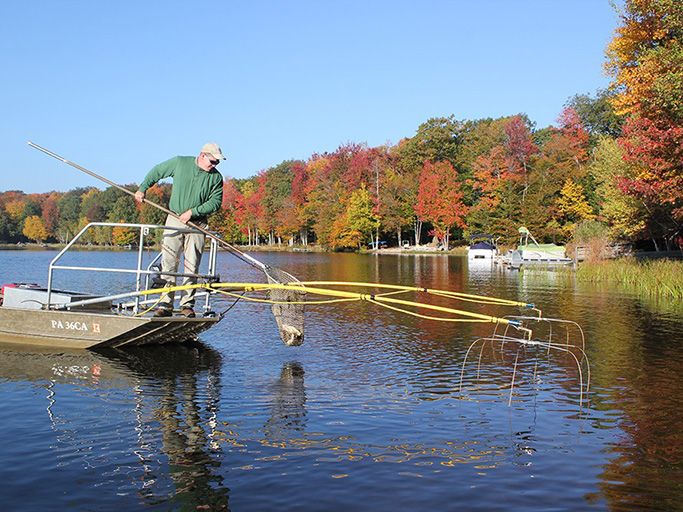To stock or not to stock fish in your pond? How do we answer this question? The answer isn’t as simple as it may seem. Many pond owners have aspirations of owning a pond with impressive fish, and often think that to achieve a healthy fishery, they need to stock their pond with the fish they want. However, this isn’t always the case.
Freshwater ponds have fish populations that are composed of fish that fall into one of two categories: predator fish or forage fish. Predator fish feed on forage fish and prevent them from overpopulating to keep a balanced population and healthy pond environment. Predator fish are very important because having a balanced fish population is absolutely essential for maintaining a healthy fishery.
How Do I Know if I Have a Balanced & Healthy Fish Population?
So, we know it’s important to have a species balance in your pond. But how is that achieved? A balanced population normally consists of a population with four pounds of forage fish for every pound of predator fish. How can you tell if your pond is meeting these criteria? To evaluate your pond’s fish population, you first need to conduct an electrofishing survey. This survey allows you to look at your predator fish to forage fish ratio as well as the lengths and weights of individual fish. By conducting this survey, you will be able to tell what needs to be done in order to achieve and maintain a healthy fishery.
How Do Fish Populations Go Out of Balance?
Many things can cause a fish population to go out of balance. In some fish populations, predator fish are removed much faster than the forage fish and the population quickly shifts to one that is out of balance.
Keeping a balanced population may also depend on the fish species present. Certain predator species work better with certain forage species. Generally, a forage fish works well with a predator that shares the same habitat.
Populations can also become unbalanced if the spawning periods of the predator and forage fish are out of sync. The spawning period for the forage fish should be shortly after that of the predator, ensuring the year’s young predators have a supply of newly hatched forage fish small enough for them to eat. If the forage fish hatch before the predators, the forage fish will quickly grow too large for the young predator fish to eat when they hatch.
A good example of a healthy, balanced fish relationship is that of the largemouth bass and bluegill populations. Bluegills share the same habitat as largemouth bass and spawn after the largemouth bass providing good forage for the young largemouth bass predators.
How to Manage a Fish Population
The first thing you must do to keep a healthy fish population is to match the proper predator fish with the proper forage fish. Continue to manage the forage fish population to produce large numbers of young fish on which the predators can feed. The predator fish must also be maintained in large enough numbers to prevent the forage fish from overpopulating. Overpopulation of forage fish may cause reproduction to decrease and deteriorate the entire water body population. If the opposite occurs and the predator fish numbers are too high for the available forage base, this can cause overcrowding, resulting in stunted growth and poor weights of fish. Overcrowding and overpopulation of fish can also cause an imbalance of a water body’s plant species, resulting in an extremely unhealthy environment.
Situations That Require Fish Stocking
In most cases, fish stocking in bodies of water is a personal preference of the owner or manager. However, there are several situations that require fish stocking. These can include:
- Overpopulation of predators: In this situation, a portion of the predator population must be removed so that the remaining fish will have more food available. If there are no adult forage fish, then stocking adult forage is essential. These mature adults are not consumed as food and will reproduce, creating more food.
- Overrun population of forage fish: To counter this, predator fish must be stocked to eat more of the forage and reduce the population.
- Predator species not compatible with forage: If the species aren’t compatible, it will be necessary to stock a predator fish species that prefer your forage.
There is no need for stocking in a balanced fishery. If you wish to continue to improve your fishery and the size/health of your fish, stocking of baitfish will increase growth and take some pressure off of your forage. Take a survey of your fish to determine if you should or should not stock your pond in order to achieve a balanced fishery.
What Fish Should I Stock My Pond With?
Half the beauty of having a pond comes from the ability to support wildlife. Fish are an excellent addition to a pond and can help you create a gorgeous, dynamic water feature that will entertain anglers and delight guests of all ages. Fish are also an important part of a pond’s ecosystem, affecting the health of aquatic plants and birds. But with over 33,000 species of fish out there, how do you choose the right ones for your pond?
The answer to that depends on what exactly you’re looking for, but we’ve got you covered. Learn more about the best types of fish for a pond, and when you’re done, reach out to the pros at AEC Lakes for assistance with stocking.
Best Types of Fish to Stock
There is a wide variety of fish you can add to a pond, each with their own ideal climates and cohabitating species. Here’s how some popular species stack up:
- Largemouth bass: Largemouth bass are great predators, making them a good fit for ponds with a lot of smaller prey fish. These bass need large amounts of forage and can help control bluegill populations. They’ll reproduce in most ponds, but having other predators like bluegill can help keep the population down.
- Smallmouth bass: Smallmouth bass are a little pickier than largemouth bass, requiring rocky substrates and cool water that’s difficult to find in small ponds. But for deeper, large bodies of water, especially those with sand or gravel, they’ll fit in just fine. They don’t compete well with largemouth bass, though, so it’s best not to put both species in the same pond.
- Walleye: Another good predator fish, walleye are great for large, cool lakes and can help manage overpopulation of yellow perch. However, they aren’t always the best choice for ponds and should only be used in limited numbers in large waters. They’ll need a strong forage base with fish like perch, fathead minnows and bluegill.
- Bluegill: Bluegill do well in warm, heavily vegetated areas of a pond or lake and serve as an excellent source of food for largemouth bass, who can also help keep this population down. They’ll feed on small fish and insects.
- Crappie: If your pond or lake is larger and will host anglers, stocking with crappie is a good choice. These fish can help control sunfish and bluegill populations, but they may need to be kept in check by some larger predator fish like bass.
- Perch: Perch are a popular choice and do well in the same kind of environment as bluegill — warm, heavily vegetated waters. They tend to overpopulate, so adding some predators is usually necessary, and they will need a robust stock of prey like fathead minnows.
- Baitfish: Baitfish include minnows and shiners, which reproduce in large numbers and can be controlled with forage-hungry fish like largemouth bass. They like to spawn in woody structures in the water.
Things to Consider When Choosing a Species to Stock
The best type of fish for your pond will depend on a variety of factors. It’s something of a balancing act, but some of the important things to consider include:
- Pond size: Not all fish are suitable for smaller ponds, so you’ll need to consider what’s best for the type of fish you’re hosting. A warm, slow-moving pond, for instance, isn’t well-suited to smallmouth bass or walleye, but could be the perfect home to bluegill and largemouth bass.
- Predator-to-prey ratios: To avoid overpopulation and food chain issues, you’ll need to keep your predators and prey in check. Think about which fish reproduce heavily and which ones need high supplies of forage fish to feed on. They make great pairs and can keep each other in control. This ratio will also depend on the size of the pond.
- Pond location and year-round temperature changes: Make sure your local climate is a good fit for the type of fish you’re stocking. Southern lakes and ponds can support warm-water fish such as largemouth bass and bluegill, while regions further north are good for fish that like colder waters, including smallmouth bass and trout.
Stock With the Experts at AEC Lakes
Still not sure what kind of fish is right for your pond? At AEC Lakes, we have decades of experience and understand the intricacies that go into managing and stocking a pond. Our team is happy to help you choose the right fish, order them and get them acclimated to their new environment.
Every pond is unique, from climate and vegetation to size, purpose and wildlife. The sensitive biological landscape of a pond or lake depends on the interaction of many different factors, and we can make sense of them all to help you make the perfect choice of fish for your water. Read up on fish stocking or request a consultation to talk to an expert about filling your pond or lake.
The experts at Aquatic Environment Consultants, such as our president, Bill (pictured above), are experienced in fish surveying, stocking, and ongoing fish management. If you have concerns about your fish population or would like to stock fish in your pond, don’t hesitate to contact us! Schedule your fish stocking consultation today.




1 Comment
Add Comment